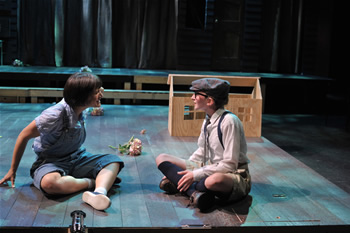Guilford College’s Dana Auditorium had a good turnout of music lovers for a wonderful program of musical painting both literal and impressionistic. This concert featured the second of the Eastern Music Festival’s all-student Young Artists Orchestras. Richard Wagner’s stirring depiction of a storm at sea, The Flying Dutchman Overture, was followed by the chilly arctic landscape of Jean Sibelius’ Violin Concerto in D minor, Op. 47. Claude Debussy’s musical evocation of Spain, Iberia, from Images Pour Orchestra ended the evening with a flare. Conductor José-Luis Novo led his students through finely disciplined and stylish performances.
Wagner’s opera Der Fliegende Holländer (1843) is the earliest of his operas to be accepted as part of the canon of mature works staged by the Bayreuth Festival. The graphic storm section was inspired by a short sea trip to England that lasted three weeks because of tempestuous seas. The rousing opening music is the leitmotif for the Dutchman condemned to sail ceaselessly until a woman is willing to die to free him from his curse. The prayerful melody evokes Senta whose suicide releases his spirit. Most of the overture is early Wagner but the sophisticated finale is the mature Wagner of some 30 years later.
Novo led his skilled students in a stirring, red-blooded performance. Each orchestra section’s ensemble was excellent. The important brass parts come off vividly and the woodwinds were strongly characterized. The strings produced a great rich tone.
After the Violin Concerto’s premiere in 1904, Sibelius made an extensive revision, premiered in 1905, which was the version played here. It is in three movements. Murmuring muted violins open the piece as the violin soloist enters playing the principal theme of the movement, a rhapsodic melody, soon taken up by the darker woodwinds. A second, slower theme is spun out by the dark colors of cellos and bassoons. These themes spread and interweave like branches of a tree. A sighing phrase in thirds for woodwinds opens the second movement and is echoed by other winds before the violin spins out a deeply melancholy Romantic melodic line. After building to a climax, the movement ends with hushed nostalgic phrases. The last movement, described by Donald Tovey as “a polonaise for polar bears,” is a wild dance. Sibelius scales the accompaniment down in pitch and chamber music size to let the solo violin’s sound cut through. The extraordinary technical challenges for the soloist are passages of thirds, arpeggios, harmonics, double-stops, among many other violin fireworks.
Festival Orchestra concertmaster Jeffrey Multer was the violin soloist. He played with a fine sense of style and immaculate intonation. His quiver of technique seemed bottomless as he tossed off the many challenges Sibelius has thrown at the soloist. His articulation in the fastest passages was breathtaking. A highlight of the first movement was a dialog between Multer and principal violist Michael Zahlit. Novo led a sensitive accompaniment with close attention to balance between the orchestra and soloist. Each orchestral section played with excellent ensemble with strong showings from every section.
In the three-part Iberia section from Claude Debussy’s triptych Images pour Orchestre (1905-10), the composer sought to evoke the “feel” of Spain by his recreating the characteristics of real folk tunes without actually quoting any real ones. Debussy “knew” Spain from art and literature and a brief visit to a small border village of San Sebastian to see a bull fight. Still most regard Iberia as the best “Spanish” music ever composed. The first part explodes with bright orchestral color and vivid dance rhythms accented with castanets and a tambourine. Instead of plucked pizzicato strings, the violins, violas, and cellos strum their strings like a guitar. Brassy horns and trumpets brighten a brief dark episode. The second movement is a nocturne conjured by shimmering violins, nostalgic airs in the woodwinds, and plush, rich harmonies in the low strings. The distant sound of bells leads directly into lively folk-like dances of the third section.
Novo led a vivid and colorful performance with excellent solo turns from many student section principals. The pairing of oboist Leland Greene and English Horn player Tamara Winsten in both the second and third sections was delightful and Leland‘s extensive second section solo was superb. Concertmaster Ingang Han’s solo episodes in both of the last two sections were beautifully done. Other fine solos were played by first horn Kelsay Jones, principal flute Lidyia Selikov, and by principal trumpet Emily Nastelin.











